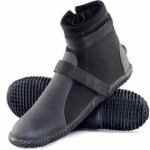Neoprene, a synthetic rubber material, is renowned for its versatility and exceptional insulating properties. From wetsuits to gloves and other protective gear, neoprene is used across various industries where temperature control is critical. But what makes neoprene such an effective insulator? In this article, we will explore the science behind neoprene’s insulating abilities, what sets it apart from other materials, and why it’s a top choice for products designed to protect against heat and cold. Whether you’re in the market for custom neoprene products or looking to understand how neoprene performs, this guide will provide you with the answers.
Neoprene works as an excellent insulator due to its unique closed-cell structure, which traps air and provides a barrier against temperature extremes. This makes it ideal for use in both hot and cold environments, ensuring comfort and protection.
To better understand why neoprene is such a great insulator, let’s first look at what neoprene is made of and the specific properties that contribute to its insulating capabilities.
What is Neoprene?
Neoprene is a type of synthetic rubber that was first developed in the 1930s by scientists at DuPont. It is created by polymerizing chloroprene, which forms a durable, flexible, and water-resistant material. Neoprene is widely used in various applications, from wetsuits and diving gear to laptop sleeves, gloves, and industrial seals. What sets neoprene apart from other materials is its ability to maintain its integrity under extreme conditions, such as exposure to heat, cold, and water. Its versatile properties have made it a popular choice for both personal protective equipment and commercial products.
Neoprene is a durable, flexible synthetic rubber that is known for its resistance to environmental factors like heat, cold, and water. These properties make it an ideal material for use in products that require temperature regulation.
Neoprene’s chemical structure contributes to its unique properties. The polymerization of chloroprene molecules results in a material that can withstand a wide range of temperatures, making it suitable for everything from thermal insulation to waterproofing. Its closed-cell structure, where tiny air pockets are trapped within the material, is a key factor in its ability to insulate effectively.
What Properties of Neoprene Contribute to Its Insulation?
The insulation properties of neoprene can be attributed to a combination of its molecular structure and physical attributes. One of the most important characteristics that make neoprene a good insulator is its closed-cell structure. This unique design allows it to trap air within its cells, creating a thermal barrier that prevents heat transfer. Additionally, neoprene’s flexibility and water resistance contribute to its ability to maintain its insulating properties even in wet conditions, where other materials might lose their effectiveness.
The closed-cell structure of neoprene traps air, providing an effective barrier against heat and cold. This characteristic, combined with its flexibility and water resistance, makes neoprene an excellent material for insulation in both wet and dry environments.
The closed-cell structure not only provides thermal insulation but also makes neoprene buoyant and water-resistant. Each cell within the material contains small pockets of air, which act as tiny insulators. When neoprene is used in wetsuits, for example, these trapped air cells help keep the body warm by reducing heat loss to the surrounding water. The material’s water resistance also ensures that it does not absorb water, further maintaining its thermal insulation properties in cold, wet conditions.
How is Neoprene a Good Insulator?
Neoprene is considered a good insulator due to its ability to minimize heat transfer, keeping your body or belongings at a desired temperature. But how does it work exactly? The key lies in the material’s structure and how it interacts with the environment. Unlike other materials that conduct heat or cold, neoprene’s closed-cell structure acts as a barrier, preventing the flow of temperature from one side to the other. Whether you’re looking to keep warm in cold waters or keep an item cool, neoprene serves as an effective thermal shield.
Neoprene insulates effectively by creating a barrier that traps air and resists the flow of heat. This makes it ideal for use in cold or warm environments, where temperature control is necessary.
In addition to its closed-cell structure, neoprene’s physical properties also play a role in its insulating capabilities. The material’s density and thickness can be adjusted depending on the intended application, allowing for customized insulation. For example, thicker neoprene is used in wetsuits to provide more warmth in cold waters, while thinner versions are used in products like laptop sleeves to keep devices cool. The flexibility of neoprene allows it to conform to the shape of the wearer or item, creating a snug, efficient barrier against temperature extremes.
How Does Neoprene Work to Keep Things Warm or Cool?
Neoprene works by minimizing the transfer of heat and creating an effective thermal barrier. When used in products like wetsuits, gloves, or insulative liners, neoprene keeps the body warm by trapping the heat produced by the body, while simultaneously preventing cold external temperatures from penetrating. On the other hand, neoprene also works to keep things cool by acting as a barrier against external heat, helping to maintain the internal temperature of a product or beverage. This versatility makes it a popular choice for a wide range of applications.
Neoprene keeps things warm by trapping the heat produced by the body, while its closed-cell structure prevents cold from entering. In cooling applications, neoprene works by blocking external heat and maintaining a consistent internal temperature.
The ability of neoprene to insulate against both cold and heat is part of what makes it so versatile. In cold-water sports, neoprene wetsuits trap the body’s heat, allowing the wearer to stay warm despite the low external temperature. For hot environments, such as in the case of neoprene-based coolers or insulating gloves, the material works to block external heat from warming up the contents inside. This dual-purpose functionality is one of the reasons why neoprene is favored in products requiring temperature control.
Conclusion
In conclusion, neoprene is an excellent insulator due to its unique closed-cell structure, flexibility, and water resistance. It works by trapping air within its cells, which prevents heat from escaping or entering. Whether keeping you warm in cold water or protecting items from temperature fluctuations, neoprene provides effective insulation in a variety of conditions. If you’re looking for a customizable, durable material that performs well under both heat and cold, neoprene is the ideal choice. Reach out to us today for custom neoprene products tailored to your specific needs.











